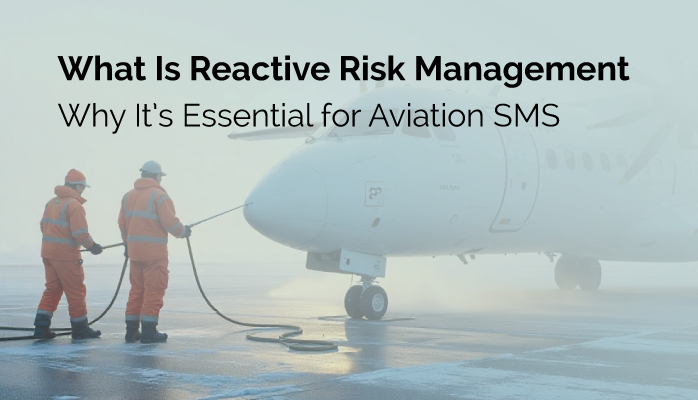What Is Reactive Risk Management

Reactive risk management usually gets a bad rap. It’s often perceived as the “lowest” form of risk management, and those aviation service providers should be moving from reactive risk management towards more “advanced” forms to manage risk.
All employees must understand that reactive risk management is extremely valuable to all aviation safety management systems (SMS) implementations.
Reactive risk management simply involves the ability to respond quickly to safety events.
Related Articles in Reactive Risk Management in Aviation SMS
- Difference Between Reactive, Predictive and Proactive Risk Management in Aviation SMS
- How to Practice Reactive, Proactive, and Predictive Risk Management in Aviation SMS
- Going From Reactive to Predictive Risk Management in Aviation SMS
Defining Reactive Risk Management in Aviation SMS
By definition, reactive risk management is a response-based approach to risk. This means that reactive safety management is practiced after a hazard has manifested itself and your company has suffered risk-related consequences. To put this into language for the layperson, safety management teams are responding to an event, which may be an:
- Accident;
- Incident; or
- Irregularity.
This is sometimes described as “firefighting,” though I think “stress testing” is closer to the mark because responding to events measures an SMS':
- Ability to mitigate consequences and impacts (i.e. damage control);
- Adaptability and resilience; and
- Decision-making ability.
A few important things to understand about reactive risk management are:
- There can be good and bad reactive safety management;
- Valuable for aviation safety programs of all maturity levels, from both new and mature programs;
- Involves specific types of actions and behavior; and
- Can be a fantastic risk control with the right preparation (i.e. training).
Reactive techniques should be actively cultivated and evaluated in every program.
When to Use Reactive Risk Management in Aviation SMS
Different situations will require different actions on the part of employees and management. In non-risk situations, such as everyday operations, proactive risk management should be the primary mode of operation.
However, practicing proactive risk management is often impossible, impractical, or even unadvisable. Some situations that exemplify when specifically to practice reactive safety management are:
- Aviation SMS training courses based on decision making;
- After an event has occurred; and
- In newer SMS implementations without the requisite experience/data for proactive management activities.
Again, reactive techniques can be good or bad. Poor decision-making preparedness results in the kind of reactive risk management that is stereotyped as bad.
But quality response techniques and decision-making ability are a considerable asset to every organization. They demonstrate the kind of reactive risk management that is desirable for any aviation SMS.
Why Your SMS Needs to Have Good Reactive Strategies

Aviation SMS implementations that don’t have good reactive risk management strategies unnecessarily expose themselves to considerable risk. Even mature SMS implementations that exhibit high-quality proactive strategies but have not developed quality reactive strategies will be plagued by an inability to effectively mitigate safety events once they occur. In such an aviation SMS, risks that do occur will constantly result in undesirable events and avoidable consequences.
Ultimately, your SMS needs strong reactive safety management techniques in order to:
- Cultivate a strong safety culture;
- Create an employee base whose decision-making can be relied upon as a risk control;
- Avoid undesirable events and consequences; and
- Creating a performing aviation SMS – which is adaptable and resilient.
Nascent Aviation SMS focuses on reactive risk management strategies early on in the SMS implementation. The tone management sets in the early stages toward the importance and value of the SMS will carry forward for many years. A common theme occurs in organizations with poor hazard reporting cultures: management places little value on the SMS and neglects to communicate the value early in the SMS implementation.
Safety cultures are difficult to change and can require years to move from an apathetic safety culture to a culture that sincerely embraces both SMS concepts and the SMS. Companies with poor hazard reporting cultures will not have enough data collected to realize value from the SMS during the predictive risk management phase. If you have the ideal vision of stopping an accident before it happens, the organization must be actively participating in reporting all safety concerns, especially close calls.
Strong safety reporting cultures expect employees to report:
- Accidents and incidents that have occurred;
- Potentially hazardous behaviors or conditions; and
- All close calls, regardless of whether the organization suffered risk-related consequences.
Consequently, your SMS depends on a strong safety culture that has healthy hazard reporting activities should you wish to realize the true benefits of an SMS.
Related Aviation SMS Safety Culture Articles
- What Is Safety Culture in the Aviation Industry?
- Indicators of Good Hazard Reporting Culture
- How Aviation Safety Managers Can Improve Safety Reporting Cultures
Who Practices Responsive Risk Management?
It’s important to remember that reactive risk management happens at every single level of an organization – not just with front-line employees or just with management:
- Front-line employees will need to actively respond to risks and sudden dangers in a way that ameliorates the problem;
- Department heads assigned to safety reports will need to make split-second decisions that can have wide-ranging consequences on safety; and
- Safety management team will need to monitor and improve responsiveness abilities.
Employees should always understand that risk is managed by every employee, and not just by “management.” In addition, all employees must understand their duties and responsibilities to the SMS. Hazard reporting should be both expected and required from employees who have identified a hazard.
How to Improve Reactive Risk Management

Improving the ability of your employees to respond involves actively working on safety culture in the following ways:
- Reactive risk management training;
- Human factors training;
- Training about decision making processes;
- Hazard identification training;
- Providing employees with many risk management tools, such as checklists, mobile hazard reporting, etc.; and
- Just Culture and transparency regarding discussing past safety issues and how decisions impacted those issues.
One of the primary reasons we see troubled SMS implementations is that they don’t actively discuss decision-making in their SMS management circles, and/or don’t spend the resources on reactive training in favor of spending resources on proactive training.
In order to improve the decision-making ability and responsiveness of employees, an organization needs to understand that reactive and proactive are equally valuable.
Do your employees know what is a hazard? A risk?
Do employees understand the purpose of risk controls and how to use risk controls in their assigned area of responsibility?
Do employees understand how to identify a hazard and what to do when unmitigated hazards are identified?
Hazard identification training is an important element in reactive risk management training. An employee who knows how to report a hazard or accident is great! An employee who is willing and able to report hazards and events offers even greater value to the SMS.
Finally, an employee who knows how to spot various sorts of operational hazards, and is willing and able to report the hazard offers the most value to the SMS. This is why safety teams should not skip or breeze through hazard identification training. Most employees may not know what types of issues to report until you tell them. This holds true with a strong ability to identify and report hazards. Employees need good hazard identification training.
Related Aviation Hazard Identification Articles
- 4 Pillars | What Is Hazard Identification in Aviation SMS
- FAA Part 5 Compliance | Safety Risk Management Hazard Identification Requirement
- 4 Tips to Approach Hazard Identification in Aviation SMS
What Reactive Safety Management Is NOT
It’s useful to point out what reactive risk management is not so that you have a reference point to compare. Conceptually, it’s NOT:
- A lesser form of risk management;
- A hallmark of new SMS implementations (it’s present in all safety programs);
- Only relevant to immature SMS implementations; and
- A waste of time and money to train and discuss.
The above points are just some of the stereotypes that keep operators from best-in-class safety performance. Most importantly, if you want to improve reactive risk management you need to understand risk fundamentals, as well as the practical application of risk techniques. There are several strategies to improve your risk management abilities if you are new to SMS. These strategies include:
- Hiring an SMS consultant to help implement your SMS;
- Attend SMS training courses or college degree programs; or
- Purchase an SMS database that comes with SMS training materials.
Final Thoughts on Learning Reactive Risk Management
An SMS database provides your company with an immediate SMS solution that comes with industry-defined workflows. This is the fastest way to success. Not only will you learn about reactive risk management, but you will also have hazard reporting and risk management tools ready for you to quickly set up your SMS.
A low-cost, commercially available SMS database can not only assist in reactive risk management activities but also manage:
- SMS training;
- Auditing;
- Safety promotion activities; and
- Safety assurance.
If you are struggling with SMS processes or SMS data management, we can help. We work with hundreds of aviation service providers worldwide each year to help them succeed with their SMS implementations. If you want to have a baby without labor pains, learn how you can benefit from our SMS database solution.
Want to Watch Demo Videos Instead?
Last updated August 2025.






